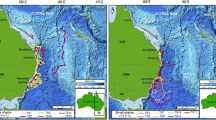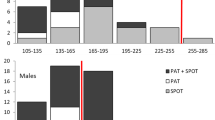Abstract
To date, movement patterns of juvenile sand tigers (Carcharias taurus) along the east coast of the USA have been loosely defined. Given the magnitude of the purported decline in the sand tiger population in the western North Atlantic (WNA), characterization of the species’ movement patterns throughout this broad area is essential for the effective management and recovery of this population. Using passive acoustic telemetry, pop-up satellite archival transmitting tags, and conventional fishery-dependent tag/recapture data, seasonal movements of juvenile sand tigers (ages 0–2 years; <125 cm fork length) were monitored between Maine and Florida along the US east coast from 2007 to 2013. Collectively, tag data indicated that juvenile sand tigers undergo extensive seasonal coastal migrations moving between summer (June–October) habitat (Maine to Delaware Bay) and winter (December–April) habitat (Cape Hatteras to central Florida) during the spring (April–June) and fall/early winter (October–December). Juvenile sand tigers occurred in a wide range of temperatures (9.8–26.9 °C) throughout the year, but spent the majority of their time in water from 12 to 20 °C. Given the extensive movements and continuous utilization of relatively shallow (<80 m) nearshore waters exhibited by these relatively small individuals throughout their first years of life, it is imperative that precautions be taken to limit negative effects of anthropogenic interactions on this species (i.e., fisheries bycatch, coastal degradation) in an effort to rebuild and sustain the WNA population.









Similar content being viewed by others
References
ASMFC (Atlantic States Marine Fisheries Commission) (2008) Interstate fishery management plan for Atlantic coastal sharks. ASMFC, Washington, DC, p 172
Bansemer CS, Bennett MB (2011) Sex- and maturity-based differences in movements and migration patterns of grey nurse sharks, Carcharias taurus, along the eastern coast of Australia. Mar Freshw Res 62:596–606
Bass AJ, Ballard JA (1972) Buoyancy control in the shark Odontaspis taurus (Rafinesque). Copeia 3:594–595
Bass AJ, D’Aubrey JD, Kistnasamy N (1975) Sharks of the east coast of southern Africa. IV. The families Odontaspididae, Scapanorhynchidae, Isuridae, Cetorhinidae, Alopiidae, Orectolobidae and Rhiniodontidae. Invest Rep Oceanogr Res Inst S Afr 39:102
Bigelow HB, Schroeder WC (1953) Fishes of the Gulf of Maine. Fish Bull 53:74
Castro J, Woodley CM, Brudeck R (1999) A preliminary evaluation of the status of shark species. FAO fisheries technical paper no. 380, FAO, Rome, p 72
Cliff G (1989) The breeding migration of the sand tiger shark, Carcharias taurus, in Southern African waters. In: Presented at the 5th annual meeting of the American Elasmobranch Society, San Francisco State University, San Francisco, CA, USA (abstract), p 76
Compagno LJV (1984) FAO Species catalog, vol 4, part 1 and 2: sharks of the world: an annotated and illustrated catalogue of shark species known to date. FAO fisheries synopsis 125. FAO, Rome
Cortés E (2002) Incorporating uncertainty into demographic modeling: application to shark populations and their conservation. Conserv Biol 16:1048–1062
Dicken ML, Booth AJ, Smale MJ, Cliff G (2007) Spatial and seasonal distribution patterns of juvenile and adult raggedtooth sharks (Carcharias taurus) tagged off the east coast of South Africa. Mar Freshw Res 58:127–134
Dicken ML, Nance SP, Smale MJ (2011) Sessile biofouling on tags from recaptured raggedtooth sharks (Carcharias taurus) and their effects on tagging studies. Mar Freshw Res 62:359–364
Galuardi B (2010) Analyzepsat. R package version 3.0. http://code.google.com/p/analyzepsat/
Gilmore RG (1993) Reproductive biology of lamnoid sharks. Environ Biol Fish 38:95–114
Gilmore RG, Dodrill JW, Linley PA (1983) Embryonic development of the sand tiger shark Odontaspis taurus (Rafinesque). Fish Bull 81:201–225
Goldman KJ (2002) Aspects of age, growth, demographics and thermal biology of two lamniform shark species. Dissertation, Virginia Institute of Marine Science, Virginia
Goldman KJ, Branstetter S, Musick JA (2006) A re-examination of the age and growth of sand tiger sharks, Carcharias taurus, in the western North Atlantic: the importance of ageing protocols and use of multiple back-calculation techniques. Environ Biol Fish 77:241–252
Hays GC, Bradshaw CJA, James MC, Lovell P, Sims DW (2007) Why do Argos satellite tags deployed on marine animals stop transmitting? J Exp Mar Biol Ecol 349:52–60
Hueter RE, Heupel MR, Heist EJ, Keeney DB (2005) Evidence of philopatry in sharks and implications for the management of shark fisheries. J Northwest Atl Fish Sci 35:239–247
Kerstetter DW, Polovina JJ, Graves JE (2004) Evidence of shark predation and scavenging on fishes equipped with pop-up satellite archival tags. Fish Bull 102:750–756
Kneebone J, Chisholm J, Skomal GB (2012) Seasonal residency, habitat use, and site fidelity of juvenile sand tigers Carcharias taurus in a Massachusetts estuary. Mar Ecol Prog Ser 471:165–185
Kneebone J, Chisholm J, Bernal D, Skomal GB (2013) The physiological effects of capture stress, recovery, and post-release survivorship of juvenile sand tigers (Carcharias taurus) caught on rod and reel. Fish Res 147:103–114
Kohler NE, Turner PA (2001) Shark tagging: a review of conventional methods and studies. Environ Biol Fish 60:191–223
Kohler NE, Casey JG, Turner PA (1998) NMFS cooperative tagging program, 1962–1993: an atlas of shark tag and recapture data. Mar Fish Rev 60:1–87
Lucifora LO, Menni RC, Escalante AH (2002) Reproductive ecology and abundance of the sand tiger shark, Carcharias taurus, from the southwestern Atlantic. ICES J Mar Sci 59:553–561
Merson RR, Pratt HL (2001) Distribution, movements and growth of young sandbar sharks, Carcharhinus plumbeus, in the nursery grounds of Delaware Bay. Environ Biol Fish 61:13–24
Musick JA, Branstetter S, Colvocoresses JA (1993) Trends in shark abundance from 1974 to 1991 for the Chesapeake Bight region of the U.S. mid-Atlantic coast. NOAA technical report NMFS 115
Musick JA, Harbin MM, Berkeley SA, Burgess GH, Eklund AM, Findley L, Gilmore RG, Golden JT, Ha DS, Huntsman GR, McGovern JC, Parker SJ, Poss SG, Sala E, Schmidt TW, Sedberry GR, Weeks H, Wright SG (2000) Marine, estuarine, and diadromous fish stocks at risk of extinction in North America. Fisheries 25:6–30
Nielsen A, Sibert JR (2007) State-space model for light-based tracking of marine animals. Can J Fish Aquat Sci 64:1055–1068
NMFS (2006) Final consolidated Atlantic highly migratory species fishery management plan. DOC/NOAA/NMFS HMS Management Division, Silver Spring
NMFS (2009) Amendment 1 to the consolidated Atlantic highly migratory species fishery management plan: essential fish habitat. Final EFH Map for neonate/YOY sand tiger shark (Carcharias taurus). NOAA, National Marine Fisheries Service, Highly Migratory Species Management Division, Silver Spring, MD
NMFS (National Marine Fisheries Service) (1999) Final fishery management plan for Atlantic tunas, swordfish, and sharks. DOC/NOAA/NMFS HMS Management Division, Silver Spring
Otway NM, Burke AL (2004) Mark-recapture population estimate and movements of grey nurse sharks. EA project no. 30786/87, NSW Fisheries final report series no. 63
Otway NM, Ellis MT (2011) Pop-up archival satellite tagging of Carcharias taurus: movements and depth/temperature-related use of south-eastern Australian waters. Mar Freshw Res 62:607–620
R Development Core Team (2009) R: a language and environment for statistical computing. R Foundation for Statistical Computing, Vienna. ISBN: 3-900051-07-0. http://www.R-project.org/
Skomal GB (2007) Shark nursery areas in the coastal waters of Massachusetts. In: McCandless CT, Kohler NE, Pratt HL Jr (eds) Shark nursery grounds of the Gulf of Mexico and east coast waters of the United States, vol 50. American Fisheries Society symposium, pp 17–33
Skomal GB, Zeeman SI, Chisholm JH, Summers EL, Walsh HJ, McMahon KW, Thorrold SR (2009) Transequatorial Migrations by basking sharks in the western Atlantic Ocean. Curr Biol 19:1–4
Smale MJ (2002) Occurrence of Carcharias taurus in nursery areas of the Eastern and Western Cape, South Africa. Mar Freshw Res 53:551–556
Smale MJ, Booth AJ, Farquhar MR, Meÿer MR, Rochat L (2012) Migration and habitat use of formerly captive and wild raggedtooth sharks (Carcharias taurus) on the southeast coast of South Africa. Mar Biol Res 8:115–128
Watsky M, Gruber SH (1990) Induction and duration of tonic immobility in the lemon shark Negaprion brevirostris. J Fish Physiol Biochem 8:207–210
Wilson SG, Polovina JJ, Stewart BS, Meekan MG (2006) Movements of whale sharks (Rhincodon typus) tagged at Ningaloo Reef, Western Australia. Mar Biol 148:1157–1166
Acknowledgments
The authors gratefully acknowledge Dave Lindamood for enabling the initial documentation of sharks in PKD Bay, Donald Beers, and the Duxbury Harbormaster’s Office for providing dockage during sampling, Andy Danylchuk for providing acoustic tags, receivers, and creative input, and Ben Galuardi for his help with PSAT geolocation analyses. Thanks also to Nancy Kohler, Pat Turner, Lisa Natanson, and Ruth Briggs of the NMFS Apex Predators Program/Cooperative Shark Tagging Program for providing fishery-dependent tag and recapture data. This study would not have been possible without the volunteer members of the ACT Network who provided detection data including: Dewayne Fox and Lori Brown (Delaware State University); Jennifer Cudney and Andrea Dell’Apa (East Carolina University); Keith Dunton (Stony Brook University); Eric Reyier (IHA Environmental Services); Matt Bolus (University of Massachusetts Amherst); Bill Hoffman (Massachusetts Division of Marine Fisheries); Tom Savoy (Connecticut Department of Energy and Environmental Protection); Elizabeth Miller (South Carolina Department of Natural Resources); Matthew Balazik (Virginia Commonwealth University); Michael Loeffler (North Carolina Department of Environment and Natural Resources); and Carter Watterson (US Navy). This research was funded by awards from the NOAA Proactive Conservation Program, the Sea World Conservation Society, and the Massachusetts Environmental Trust as well as support from the Federal Aid in Sportfish Restoration Act. This is Massachusetts Division of Marine Fisheries Contribution No. 47.
Author information
Authors and Affiliations
Corresponding author
Additional information
Communicated by J. Houghton.
Electronic supplementary material
Below is the link to the electronic supplementary material.
Rights and permissions
About this article
Cite this article
Kneebone, J., Chisholm, J. & Skomal, G. Movement patterns of juvenile sand tigers (Carcharias taurus) along the east coast of the USA. Mar Biol 161, 1149–1163 (2014). https://doi.org/10.1007/s00227-014-2407-9
Received:
Accepted:
Published:
Issue Date:
DOI: https://doi.org/10.1007/s00227-014-2407-9




